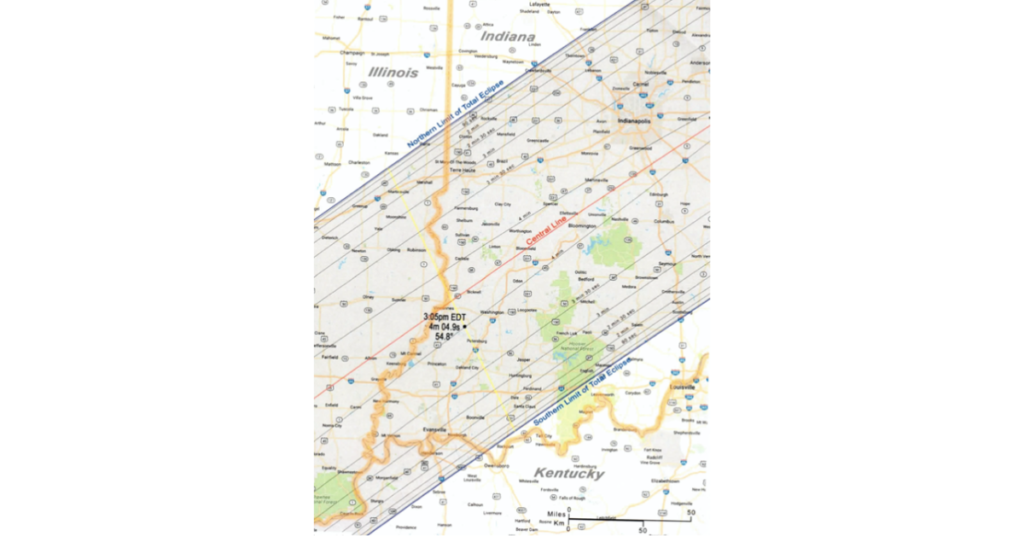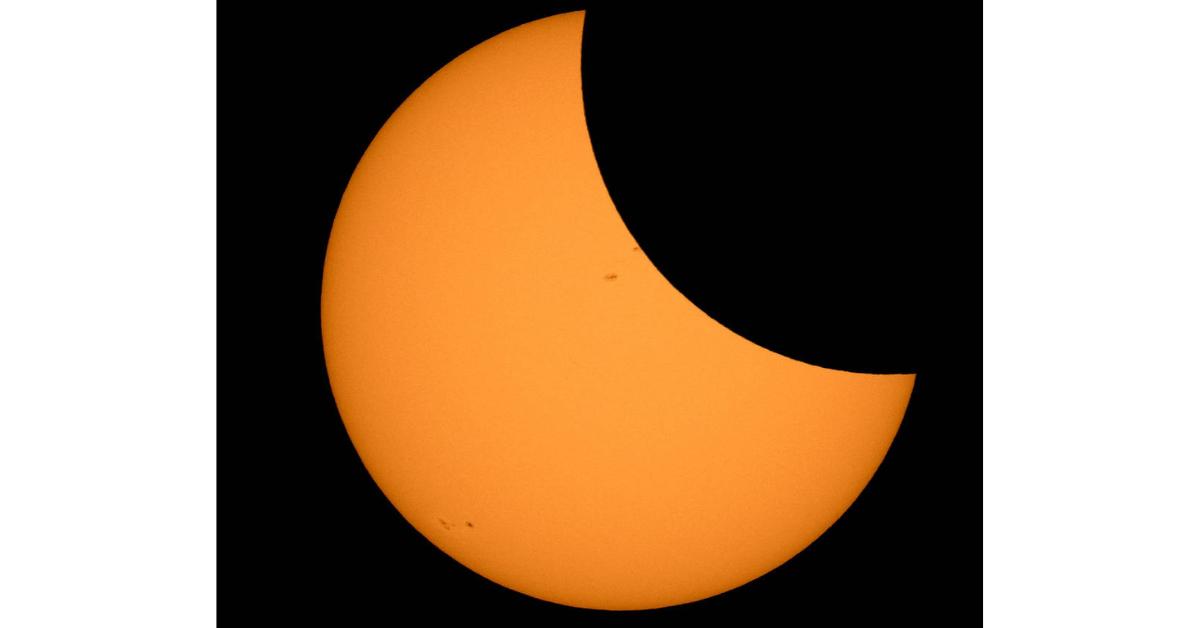Carol Johnson, Southern Indiana Business Report
One year from now on April 8, a total solar eclipse will cover a swath in North America starting in Mexico and stretching across Indiana, where about two-thirds of the state will be in the path of totality. The path of totality will be 120 miles wide where it enters the United States and will taper slightly as it crosses the country.
The total eclipse may only last 4 minutes, but months of planning is going into getting ready for a massive arrival of people to witness the total solar eclipse in 2024.
In the United States, the eclipse will start at 12:10 p.m. Central Standard Time at Eagle Pass, Texas, with totality starting at 1:27 p.m. and ending four and half minutes later. In southern Indiana, the eclipse will begin around 3 p.m.

A total solar eclipse happens when the moon lines up with the earth and blocks the sun’s light, which casts a shadow on planet Earth.
Why all the fuss? Well as one astronomer put it, “Viewing a partial eclipse is interesting, but viewing a total eclipse is phenomenal.”
For between 3 and 4 minutes, depending on your location, the sky will turn black and protective eyewear is a must to prevent eye damage. The event is so dramatic that organizers who have experience with an eclipse event say that motorists will stop wherever they are, empty fields may be populated with people and we will wonder who will pick up all the trash.
State and local governments in the path of totality have been planning for the surge in visitors for over a year. Plans should cover traffic, emergency response and public safety, parking, restrooms and availability of camping, lodging and food. Because the eclipse will occur as schools are dismissing, some schools are looking at canceling school for that day to avoid school buses getting caught in traffic.
State parks, because of their campsites and open viewing spaces, expect to be a popular destination.
“We are anticipating very large crowds,” said Sarah Murphy, assistant property manager at Spring Mill State Park in Mitchell.
The large field near the Sycamore Shelter and the lake will be prime viewing areas. Spring Mill is accustomed to managing big crowds and this will be no different. The campground has 210 full hook-up sites and those can be reserved beginning six months out from the solar eclipse weekend.
Murphy said DNR property managers have talked with other park systems in Kentucky and Illinois that have experienced being in the path of totality.
“That’s why we’re expecting big numbers. We’re used to big numbers but after hearing from them, they said strap up and get ready,” she said.
It’s expected the campsites will go quickly. Spring Mill is requiring campers make a Sunday-Monday reservation, which will help the park staff prepare for the crowd.
At the Lawrence County Tourism Commission, Executive Director Tonya Chastain said the eclipse has been on her office’s radar for about three years.
“We already have people in the county asking if they can offer campsites and parking,” she said.
Because the eclipse is on a Monday, her office is looking at planning some weekend activities for visitors who arrive early. Since people have been known to arrive two days prior to the eclipse to ensure they have a good spot for viewing, the event will benefit business in the tourism sector such as restaurants, hotels and gas stations.
“We’re looking at what the county has to offer that can accommodate large gatherings like the fairgrounds and the recreation park and how we can utilize them,” she said.
Key to managing the influx of visitors will be a central source of information. Chastain said her office will use a QR code that will contain information for the 2024 eclipse.
“Some people will plan ahead and know where they plan to watch, others will be spur of the moment,” she said. “Every county has to be prepared for ‘what if’ because if we get a large influx, we have to give them places to go.”
Ron Craig, owner of A&A Quick Pump in Lawrence County, said he’s not received any calls about renting portable toilets for that weekend, but he will be ready, he said, with 300 units available.
Once in a lifetime
Solar eclipses happen fairly often, but they don’t often happen in places that are accessible. Because of that, the eclipse will be a massive travel event as people flock to cities and towns in the totality band. For that reason, the chance to view a total eclipse can be a once-in-a-lifetime event.
The last solar eclipse that crossed the United States was in August 2017. Sam Carnell of Mitchell traveled to South Carolina to take photographs of the eclipse. Just like humans need protective eyewear, he attached special lenses to his cameras.
He said he was fortunate enough that he was able to view the eclipse in an open field with no other people around. The surrounding area, he said, was teeming with people.
So why are we fascinated with a total eclipse?
Carnell said the phenomenon of seeing the daylight darken in mid-day is like nothing else. Of course, we know today the science of an eclipse and when it’s going to take place, but such events sparked panic in earlier times.
Area cities and towns in the path of totality include Bedford, Bloomfield, Campbellsburg, English, French Lick, Fredericksburg, Jasper, Linton, Paoli, Orleans and Salem.
Lessons from 2017
The last total solar eclipse viewable from the United States occurred in 2017. It was dubbed the “Great American Eclipse,” and an estimated 215 million people viewed the event, either in person or remotely. The 2024 eclipse will be bigger and last longer than the event in 2017.
It’s unusual to have another eclipse take place only seven years after its predecessor. For example, before 2017, the last coast-to-coast total solar eclipse took place in 1918. And after April of 2024, there won’t be another total solar eclipse widely viewable from the U.S. until 2045. The bottom line is that 2024 will be a great chance to make a lasting memory of this rare celestial phenomenon.



